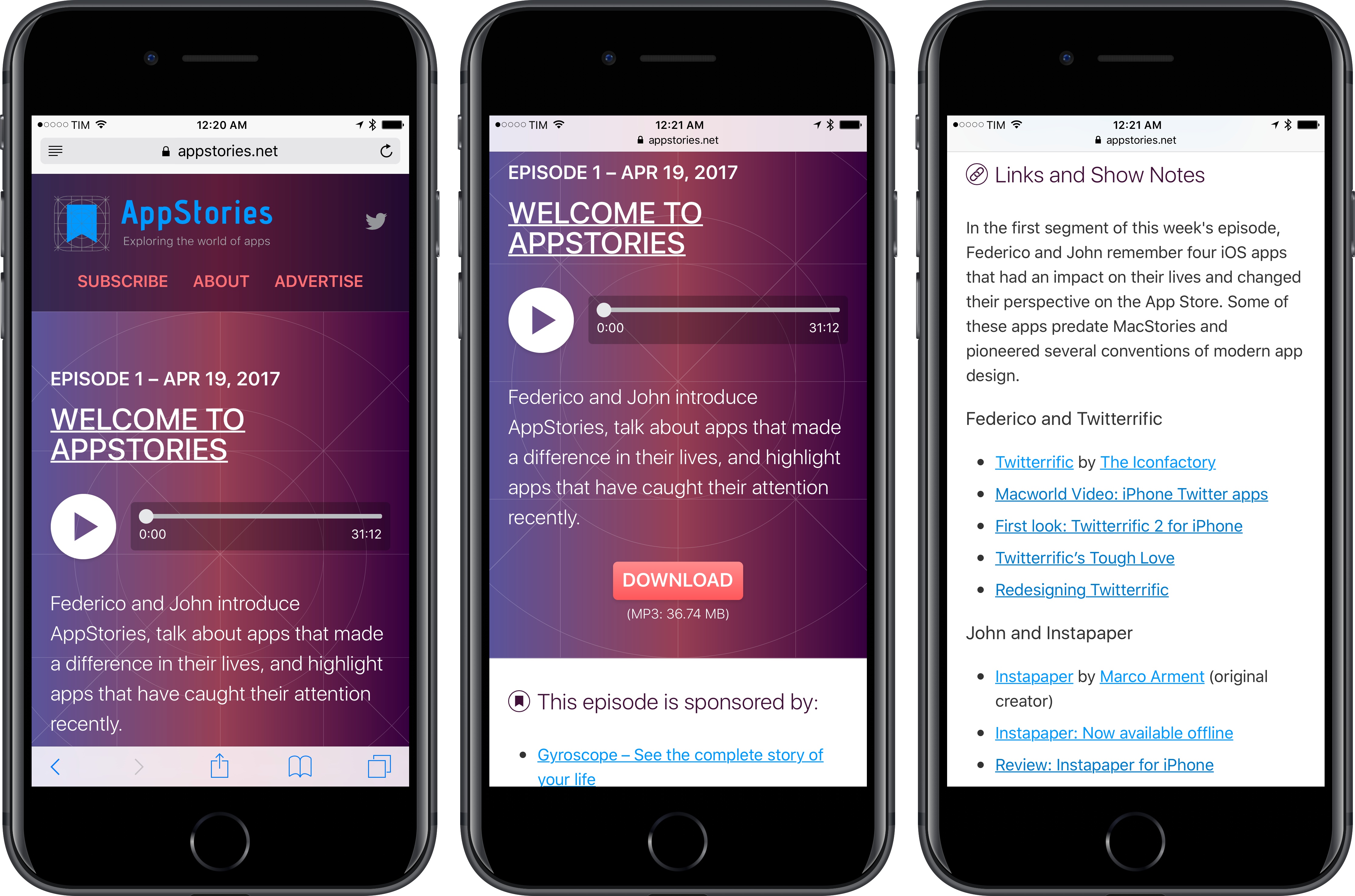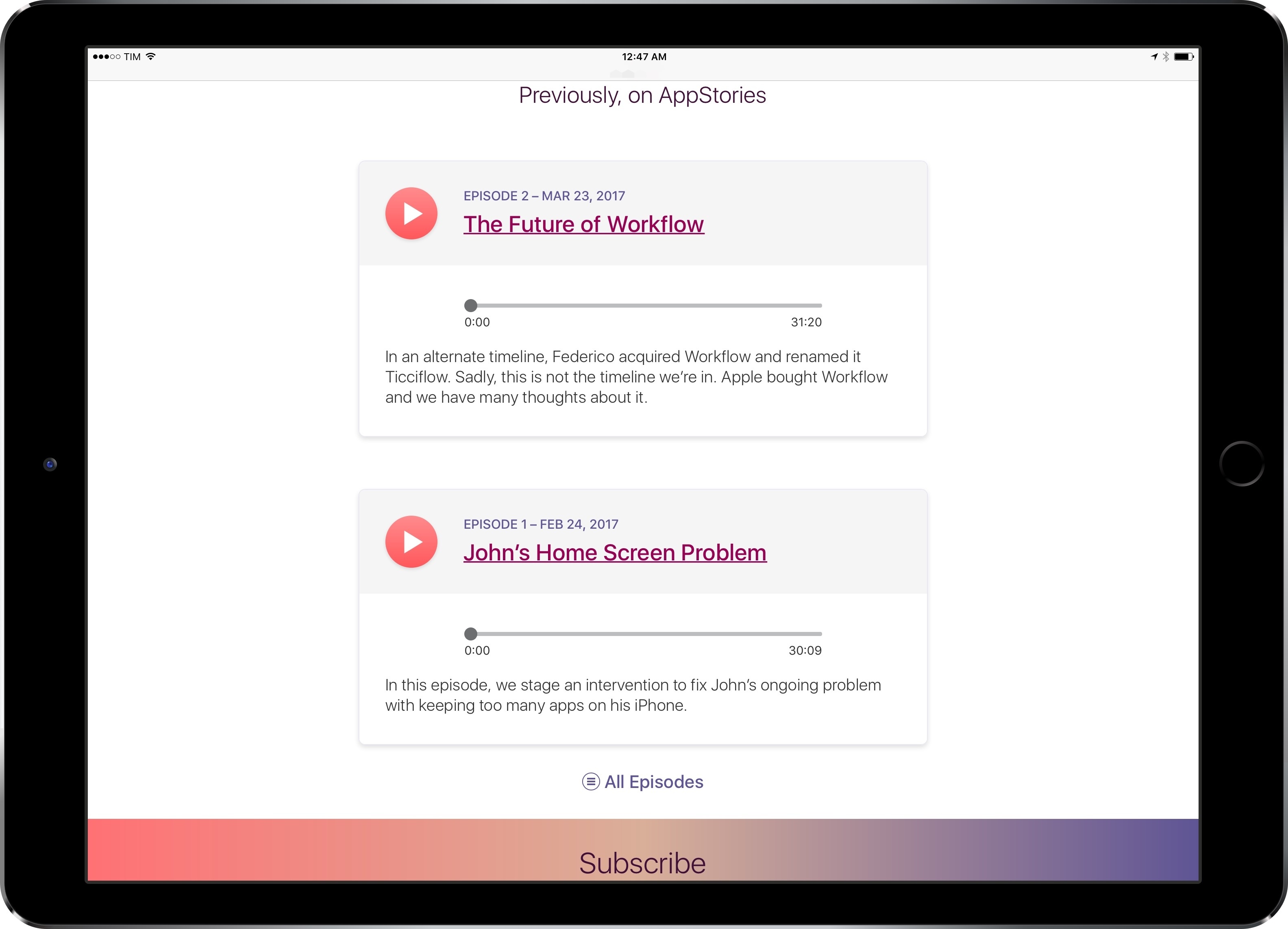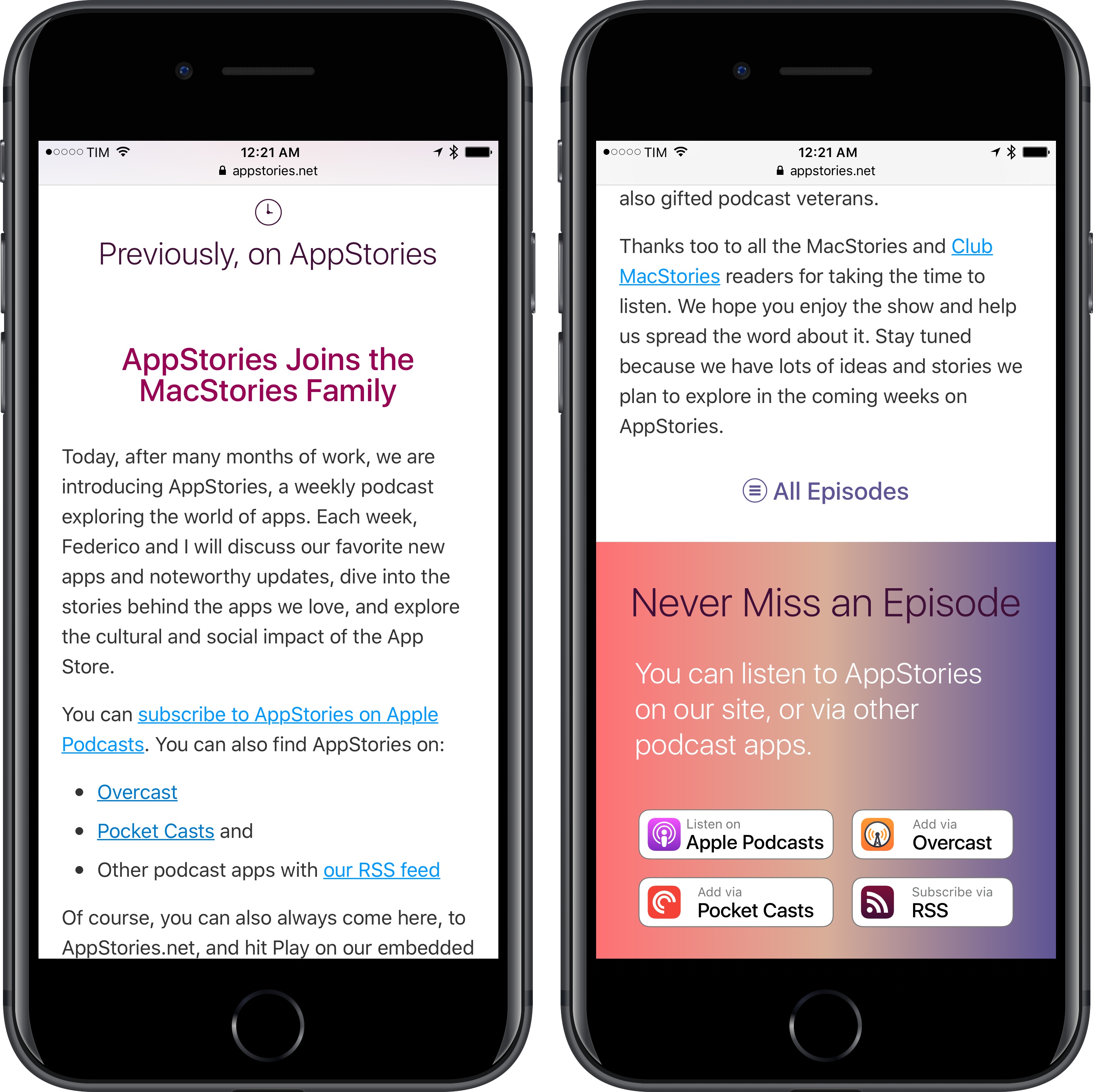In February 2010, nearly a year after I started MacStories, I registered a domain for a project I knew I wanted to launch in the future: AppStories.net.
Seven years later, AppStories finally joins the MacStories family. AppStories is the first MacStories podcast, hosted by yours truly and John Voorhees, and it’s all about the world of apps. Every week, John and I will cover our favorite apps, the human stories behind the apps we love, as well as the impact of apps on our economy, culture, and personal lives. And we’ll always do so in about 30 minutes.
You can check out AppStories’ website here, or, even better, subscribe on Apple Podcasts.
You can also find AppStories on:
- Overcast
- Pocket Casts
- Any other podcast app with our RSS feed
Alternatively, you can just hit Play on our embedded episode card below to start listening to the first episode of AppStories.
AppStories is an important milestone for the MacStories team, as well as an idea I’ve been pondering for several years. Just like MacStories, we’re committed to AppStories and we’ll keep doing this for a long time. Despite its long gestation, this is just the beginning for AppStories, which will become an essential complement to MacStories going forward. I am extremely excited about AppStories and the plans we’ve outlined so far.
If you’re not interested in the backstory, I’d love for you to check out the first episode and subscribe. But if you want to learn more and understand what our goals for AppStories are, allow me to start from the beginning.
AppStories: The Idea
MacStories wasn’t even one year old when Silvia and I thought it’d be wise to register a separate domain for a possible future expansion of the website. MacStories was just starting to generate some profit at that point (luckily, I had some savings to fall back on), and I had noticed that, between news and rumors, I enjoyed writing about apps the most.
The iPhone 4 wouldn’t come out until the summer1, and, in many ways, the App Store was still young and unproven. The iPad had just been announced and the post-PC revolution wasn’t as obvious as it is today. I knew, however, that I wanted to write about apps for a living. It felt like we were on the cusp of a major shift towards mobile devices as everyday computers, and I wanted to be part of that movement. I felt an obligation to write about apps and the stories of the developers behind them. It’s not just that I wanted – I needed to become a better writer to tell the story of computers moving from millions of desks to billions of pockets.
This obsession has driven my decisions for MacStories over the past eight years. My writing style may have changed, teammates have come and gone, but MacStories’ underlying focus has remained the same. I want to publish a website where our stories can be useful to other people, with a foundation that lets us make a living while respecting the time, attention, and investment of our readers. MacStories is all I’ve built in my professional life, and it has to be something I’m proud of. I’m still obsessed with it today as I was in 2009.
At some point over the past two years, I realized it was time to go back to the idea of a companion website specifically built to tell app stories. There’s only so much we can write about on MacStories every week – especially when most of our articles require in-depth research. A podcast seemed like an obvious idea: I had become familiar with the medium thanks to Myke, Stephen, and the entire Relay FM family; it made sense to expand our production to include an official podcast entirely created by the MacStories team.
I struggled to settle on a format that wouldn’t be yet another tech podcast loosely focused on Apple news and punditry. Producing another 90-minute show would have only recreated our problem elsewhere: it would have been another longform effort, and it would have missed the point. The AppStories.net domain was still sitting there, and I wanted to build something different, but I didn’t know how.
It was at WWDC last year – my first time at the conference – that the plan revealed itself. It wasn’t a big realization or sudden decision, but rather a natural consequence of how things had changed at MacStories and in the overall tech podcast scene since 2010.
John joined the MacStories team in late 2015, and it was clear to me that we shared the same vision for discovering new apps, talking to developers, and writing about the impact of modern iOS apps. The App Store has revolutionized our approach to software, and dozens of interesting new apps launch on a weekly basis now, often with fast iteration cycles that introduce major updates in a span of a couple of weeks. It only seemed natural that the best way to complement MacStories with more app stories was going to be a weekly, short-form, tightly edited podcast laser-focused on apps, developers, and the App Store. And when I heard the excellent interview series that John produced during the week of WWDC 2016, we both knew it was time to get to work. Thus, AppStories was officially born.
We’ve been designing, building, and discussing AppStories for the past 10 months. We’ve gone through many iterations of the website and learned a lot from our mistakes in the process, but we never drifted away from our mission and principle for the show. This is how we describe AppStories on Apple Podcasts and anywhere else:
AppStories is a weekly exploration of the world of apps by MacStories’ Federico Viticci and John Voorhees. Each week, they discuss the best new apps, the impact of apps on our culture, and cover the stories behind popular apps.
Just like MacStories is our personal chronicle of the world of Apple, AppStories will be an ongoing exploration of the world of apps. Our goal is to provide listeners with a fresh perspective on the App Store and its ramifications with episodes that are easy to follow, well-researched, and respectful of their time.
We want AppStories to stand out as the premier show entirely focused on apps. That includes interviews with app makers, an analysis of the app culture and opportunities created by the app economy, as well as stories about our own relationship with apps. We have a lot of ideas for topics to cover, and it’s going to be a long journey.
After several years in the planning stages, I feel like now is the right time for AppStories.
AppStories: The Website
I like to control as much of the technology behind our websites as possible. For AppStories, we took our time to assemble a set of tools powering a custom podcast website where episodes can be easily played, embedded elsewhere, and mixed with standard blog posts for news and announcements.
Our primary goal for AppStories on the web was to make it easy for people to start listening to an episode. Anyone who visits AppStories.net will immediately be presented with a big, bold audio player at the top highlighting our most recent episode. The player includes a large Play button that can be comfortably tapped as well as a description of the episode.
My philosophy for the AppStories website was that it shouldn’t take more than two taps to start listening. Our design accomplishes that goal on any device.
Below the latest episode, you’ll find playable cards for other recent episodes in reverse chronological order (newest to oldest). You can also tap the Play button here and listen to an episode from the card itself. Once you’ve reached the end of the selection of recent episodes, an ‘All Episodes’ button will take you to the complete archive of all AppStories episodes.
Each episode has an individual page where you can find a Download option (to grab the MP3 file) alongside show notes. To quickly open an episode’s dedicated page, you can tap on its title. Individual episodes will always be available at appstories.net/episodes/n, where n stands for the episode’s number.
For our show notes, we have set up a system that lets us create rich descriptions with formatting, lists, links, paragraphs, and even images. Depending on the podcast app of your choice, you’ll be able to view show notes that are more than a plain collection of links. Behind the scenes, we’re leveraging a combination of workflows, AppStories APIs, and custom Slack bots to help us in the show note process. This is something I deeply care about, and I wanted to get it right.
In addition, you will find occasional blog posts intermixed with episodes on the AppStories homepage. Thanks to our developer Alessandro, we built a podcast website where articles can coexist with episodes while still retaining separate RSS feeds. As listeners and readers, you can subscribe to an episodes-only feed (for podcast players), an articles-only feed, and a general feed for both types of content. You can see an example of a blog post on AppStories with this morning’s announcement from John; we plan to use this option in the future for site announcements and other fun extras.
We spent months designing the AppStories website and its brand identity with Silvia, who, once again, has done a remarkable job and has been overly patient. There are some missing functionalities from the website that we want to offer down the road (for instance, more options to browse the archive, search, and episode bundles), but we feel like we hit the right balance for this week’s debut.
Embedded Episode Cards
One of the big features that control over our backend has enabled us to build is the embedded episode card. I included one at the beginning of this article, but here it is again for context:
Because AppStories is part of the MacStories family, I felt like we needed a way for our existing MacStories readers to seamlessly sample AppStories from the website they read every day. With our system, every episode can be embedded elsewhere by appending /embed/ to its URL, which will generate a native AppStories episode card. Obviously, this is all done using open web technologies with no third-party plugins or other heavy resources. We’re not in the business of serving websites that weigh 20 MBs and load dozens of trackers for each page.
You can expect us to leverage the integration between MacStories and AppStories to reference episodes in articles and make it easy for MacStories readers to find the AppStories episodes they’re interested in. I’m happy with how this feature turned out.
AppStories: The Podcast
AppStories is a tightly-edited show, usually around 30 minutes in length; new episodes will be released weekly on Monday. We will begin our regular schedule with Episode 2, set to be released on Monday, April 24.
While we have come up with a collection of regular segments to feature on the show, we don’t want to limit ourselves to a fixed number or type of sections every week. Our goal is to be consistent but also fresh and willing to try new things. You can expect us to cover our favorite apps and notable app releases, but we’ll also feature interviews, multi-episode stories, and topics that range from app releases to discussions of the socio-economic impact of apps.
Like MacStories, AppStories’ business model is based on sponsorships. John has outlined our direction on the AppStories blog, but in a nutshell: we’re looking for great, tasteful products to advertise to our audience, and we want to allow indie developers on a budget to still promote their apps to AppStories listeners. The same two-tiered sponsorship system that we have at MacStories has been brought over to AppStories, with both websites now sharing the same sponsorship policy. If you’re interested in advertising your product/service to AppStories’ audience, please get in touch with John.
Finally, a note on subscribing to the show. AppStories is a free podcast that anyone can listen to. You can find AppStories on Apple Podcasts and listen with Apple’s app, or you can grab the Episodes RSS feed and listen in any podcast player.
If you like AppStories, please consider recommending it to a friend and leaving a review on Apple Podcasts. And if you have any comments, ideas, or feedback, feel free to send us an email or a tweet at @AppStoriesNet. We’d love to hear from you, and we want to make the best show we can.
Welcome to AppStories
I’ve been writing about apps for a while now, and yet it still feels like I’m just getting started. AppStories is an important new step for the MacStories family, and I’m approaching it with the same passion and enthusiasm that I’ve poured into this website for the past 8 years. I know that John feels the same way, and it’s been exciting to work with him to get this project off the ground.
I also have other people to thank for sharing their support and knowledge with us over the past several months. Myke and Stephen have been fantastic mentors and helped us understand and overcome the intricacies of podcast publishing and audio editing. Silvia crafted a beautiful website and designed an identity that perfectly fits the MacStories family. Alessandro turned graphics into code, building a versatile platform that can connect AppStories and MacStories and leave the door open for other integrations in the future.
It’s been a long journey, and I hope you’ll check out the first episode of AppStories and stay tuned for more.
Happy 8th birthday, MacStories; welcome, AppStories.
- It was a different time, when new iPhones launched towards the end of June. ↩︎











